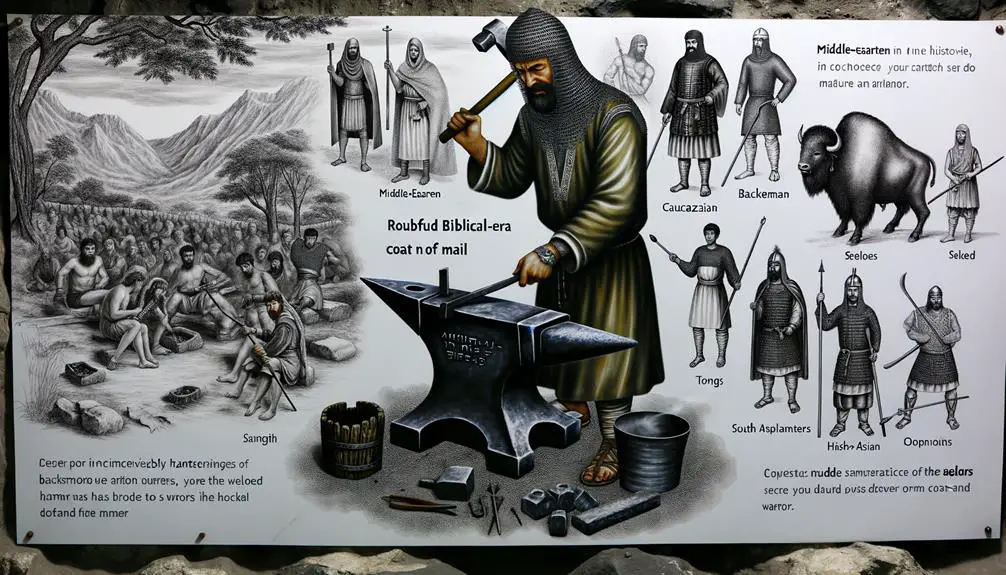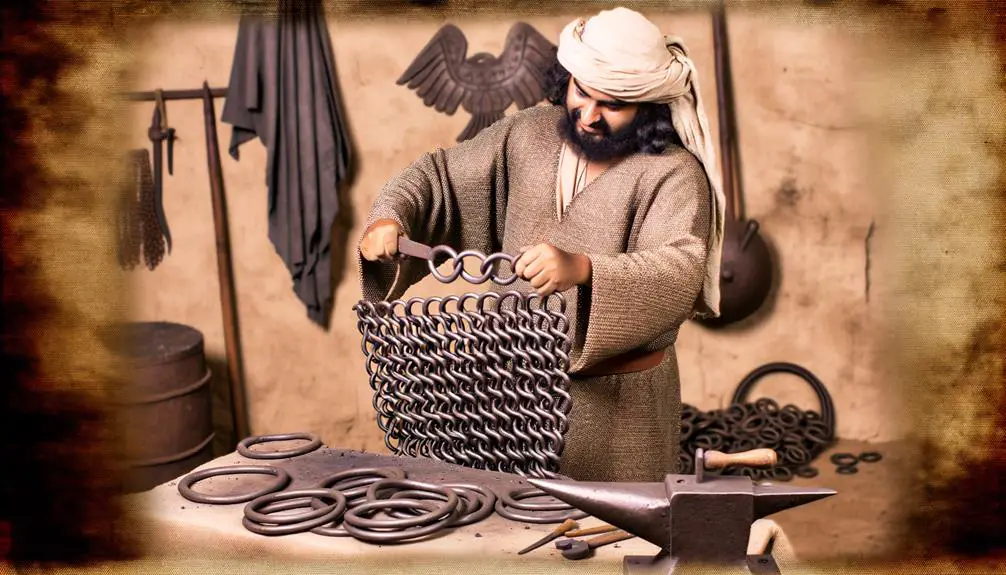What ancient battles and spiritual meanings does the biblical 'coat of mail' unveil? Dive into history to uncover its intriguing significance.

What Is a Coat of Mail in the Bible
As you're flipping through the pages of the Bible, it's quite a coincidence that the term 'coat of mail' catches your eye, sparking curiosity about its significance in ancient contexts.
This piece of armor, mentioned in the scriptures, isn't just a historical artifact; it symbolizes much more, woven tightly with the spiritual and physical battles of notable biblical figures.
You'll find that understanding its construction, materials, and the stories behind those who donned it sheds light on its profound symbolic meanings.
Just when you think you've grasped its essence, you'll discover layers of interpretations that challenge and enrich your comprehension of biblical narratives.
Key Takeaways
- A coat of mail in the Bible symbolizes physical, spiritual, and moral strength.
- It's mentioned alongside other armaments, emphasizing divine protection and righteousness.
- Notable for its role in biblical stories, like David and Goliath, highlighting faith over physical might.
- Reflects the wearer's preparedness for both spiritual and physical battles, underlining the importance of divine support.
Historical Origins and Description

The coat of mail, a vital component of ancient warfare, traces its origins back to the 3rd millennium BCE, evolving from simpler forms of body armor to become a sophisticated protective garment. This evolution wasn't merely a matter of technological advancement but was deeply intertwined with the changing dynamics of combat tactics over the centuries.
Initially, armor was rudimentary, often made from quilted linen or animal skins. However, as you delve deeper into the annals of history, you'll find that the development of the coat of mail marked a significant shift in the approach to personal protection in combat. This transition wasn't abrupt but a gradual refinement influenced by the need for mobility, flexibility, and effective defense against the increasingly lethal weapons of opposing forces.
The coat of mail, comprising interlocking metal rings, offered a balance between protection and mobility that previous armor types couldn't achieve. Its design allowed soldiers to move more freely, a crucial factor in the heat of battle where agility could mean the difference between life and death. This adaptability made it an indispensable part of military gear, reflecting a sophisticated understanding of warfare dynamics.
Furthermore, the evolution of armor, including the coat of mail, wasn't solely a technical process but also a reflection of broader changes in military strategy and combat tactics. As offensive weapons became more powerful and diverse, defensive gear had to adapt, leading to innovations in armor design and construction. The coat of mail stands as a testament to this ongoing interplay between attack and defense mechanisms throughout history.
Biblical References and Context

Exploring the biblical narrative, you'll uncover that references to the coat of mail illuminate its significance in ancient warfare as depicted within the sacred texts. This protective garment, often mentioned alongside shields and helmets, symbolizes not only physical defense but also spiritual and moral fortitude. The biblical authors skillfully weave armor symbolism into the fabric of their stories, presenting the coat of mail as a metaphor for divine protection and righteousness.
For instance, in the accounts of David and Goliath, the giant's imposing armor, including his coat of mail, underscores his might and the formidable challenge he poses. However, David's victory, achieved without such armor, shifts the symbolism to highlight faith and divine support over conventional warfare tactics.
In the context of ancient warfare tactics mentioned in the Bible, the coat of mail represents the pinnacle of personal armor, offering substantial protection to warriors amidst the clashing of swords and spears. Its inclusion in descriptions of battles and warriors serves not only to set the scene but also to emphasize the importance of preparation, both physical and spiritual, for the conflicts faced by the people of God. The detailed depiction of such armor pieces, coupled with their symbolic interpretations, enriches the biblical text, offering readers a deeper understanding of the challenges and victories experienced by its characters.
Construction and Materials

Delving into the construction and materials of the coat of mail, you'll find its design was not only a testament to ancient craftsmanship but also a reflection of the era's technological ingenuity and resource accessibility. The process of creating a coat of mail involved intricate mail making techniques, primarily weaving together thousands of interlocking metal rings. This labor-intensive method required a profound understanding of metallurgy and a high degree of precision.
Material |
Technique |
Modern Adaptations |
|---|---|---|
Iron |
Riveting |
Stainless steel rings |
Bronze |
Butted |
Lightweight alloys |
Steel |
Welding |
High-tensile wire |
Leather |
Padding |
Synthetic fibers |
Silver |
Decorative inlay |
3D printing for intricate designs |
The choice of materials ranged from iron, which was widely used due to its availability and durability, to precious metals like silver for decorative purposes. Bronze and steel were also utilized, each offering different levels of protection and flexibility. Modern adaptations have seen these materials replaced or augmented by stainless steel rings, lightweight alloys, and high-tensile wire, significantly improving the durability and weight of the mail.
Mail making techniques have evolved as well. Historical methods such as riveting, which involves the manual closing of rings, and butting, where rings are closed without being sealed, laid the groundwork for modern techniques like welding. This not only increases the mail's strength but also its longevity. Furthermore, contemporary advancements have introduced the use of synthetic fibers for padding and 3D printing for decorative inlays, showcasing how ancient designs continue to influence modern armor construction.
Symbolic Meanings and Interpretations

Shifting our focus from the tangible aspects of mail construction and materials, let's examine the profound symbolic meanings and interpretations that these coats of mail held in biblical contexts. Armor symbolism, deeply rooted in the ancient texts, extends beyond mere physical protection to embody spiritual and moral fortitudes. Interpretative variations of these symbols enrich our understanding of biblical narratives and the values they espouse.
- Divine Protection: In biblical literature, a coat of mail often symbolizes divine safeguarding. Just as the physical armor protects the body against earthly weapons, it metaphorically signifies God's ability to shield the soul from spiritual adversities. This interpretation encourages the faithful to seek spiritual armor in their walk with God, emphasizing reliance on divine strength over human might.
- Moral Integrity: The impenetrability of a coat of mail parallels the concept of moral and ethical steadfastness. It suggests that just as armor deflects physical attacks, strong moral convictions repel temptations and corrupt influences. This symbolism underscores the importance of cultivating virtues that guard against spiritual decay.
- The Battle Between Good and Evil: Armor, including coats of mail, often represents the readiness to engage in the spiritual warfare between good and evil. It embodies the preparation and resilience necessary to confront and overcome evil forces. This theme highlights the ongoing struggle between light and darkness, emphasizing the wearer's role as a warrior for righteousness.
Through these symbolic lenses, coats of mail in biblical contexts transcend their physical utility, embodying layers of spiritual meanings that resonate with interpretative variations. They remind us that the battles fought by biblical figures also mirror our internal and spiritual struggles.
Notable Biblical Figures and Stories

In the tapestry of biblical narratives, coats of mail not only serve as physical armor for notable figures but also weave into the stories profound spiritual and moral lessons. This interplay between the tangible and the symbolic is most vividly illustrated in the account of David and Goliath. The story, rich with detail and imbued with layers of meaning, showcases David's bravery not through his armor but through his faith and determination.
David's choice against wearing a coat of mail, opting instead for his sling and stones, underscores a pivotal theme in biblical literature: the triumph of faith over might. This decision marks a stark contrast to Goliath, who, adorned in his coat of mail, represents the epitome of physical strength and warfare prowess. Goliath's defeat isn't merely a tale of the underdog's victory; it's a theological statement about the power of faith and the insignificance of material armor in the face of divine support.
The narrative delves deep into the symbolism of the coat of mail. For Goliath, it signifies human reliance on physical strength and the futility of such dependence when confronted with spiritual warfare. For David, the absence of a coat of mail reveals his reliance on a higher power, showcasing spiritual armor as pivotal in overcoming seemingly insurmountable obstacles.
In analyzing these biblical accounts, you're invited to reflect on the profound spiritual and moral lessons embedded within the stories. David's bravery and Goliath's defeat transcend their historical context, offering timeless insights into the nature of faith, courage, and the true source of strength.
Frequently Asked Questions
How Did the Maintenance and Repair of a Coat of Mail Differ in Biblical Times Compared to Medieval European Practices?
In biblical times, maintaining and repairing a coat of mail relied heavily on local material sourcing, with limited tools for repair. You'd find blacksmiths using simpler forges and hammers, contrasting with medieval European practices where advancements in repair tools and material sourcing allowed for more intricate maintenance.
This period saw specialized tools developed for repairing chainmail, alongside a broader access to quality metals, significantly improving the durability and repair process of the coat of mail.
What Were the Specific Roles or Ranks of Soldiers Who Typically Wore a Coat of Mail in Biblical Armies, and How Does This Compare With Other Ancient Civilizations?
In biblical armies, the coat of mail was primarily donned by elite warriors, reflecting their high rank within the military hierarchy.
Comparatively, 90% of ancient civilizations' frontline fighters wore less protective armor, highlighting the unique armor roles in biblical times.
This distinction underscores a structured military hierarchy, where only those at the pinnacle had access to such advanced protection, contrasting sharply with the broader distribution of armor in other cultures.
Are There Any Documented Instances of Women Wearing Coats of Mail in Biblical Times, Either in Combat or Ceremonial Contexts?
You're diving into a nuanced topic, exploring whether women donned coats of mail in biblical times, touching on gender roles and ceremonial symbolism.
While direct mentions are scarce, the broader context of ancient societies suggests that, ceremonially, women could have worn such armor. However, combat roles were typically male-dominated, making documented instances rare.
Analyzing this from a scholarly perspective highlights the complexities of interpreting historical gender roles and their symbolic representations.
How Did the Introduction of the Coat of Mail Influence the Tactics and Strategies of Ancient Warfare Mentioned in the Bible?
Ironically, you'd think the introduction of the coat of mail simply made soldiers invincible, but it actually sparked a fascinating evolution in armor and siege tactics.
This advancement forced armies to adapt, leading to innovations in siege adaptations, as commanders had to rethink their strategies to overcome these new defenses.
The analysis of ancient warfare in the Bible reveals a detailed, scholarly exploration of how armor evolution influenced military tactics, making battles more complex and strategic.
Can the Use and Depiction of Coats of Mail in the Bible Be Linked to Any Specific Archaeological Discoveries in the Near East That Provide a Clearer Picture of Their Design and Use?
You're exploring how the depiction of coats of mail links to archaeological findings in the Near East, seeking a clearer understanding of their design and use.
Through material analysis, researchers have uncovered artifacts that align with biblical descriptions, offering insights into their construction.
Geographic distribution of these findings further elucidates the historical spread and adaptation of this armor, providing a more detailed, scholarly perspective on its significance and evolution over time.
Conclusion
In conclusion, analyzing the coat of mail within biblical narratives offers a deeper understanding of ancient warfare and symbolic representation.
Interestingly, it's estimated that a typical coat of mail from the biblical era could contain over 30,000 interlocking rings, showcasing the meticulous craftsmanship and laborious effort required to produce such protective gear.
This statistic not only highlights the technological ingenuity of ancient societies but also underscores the significant value placed on protection and status within these historical contexts.



Sign up